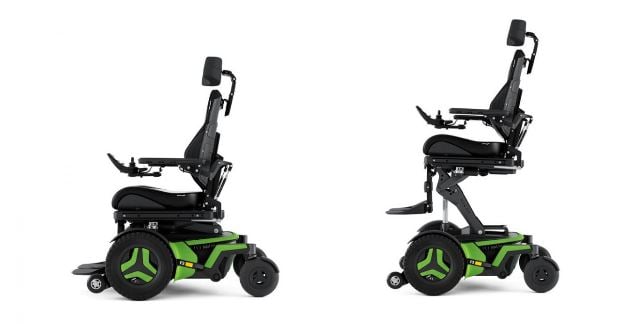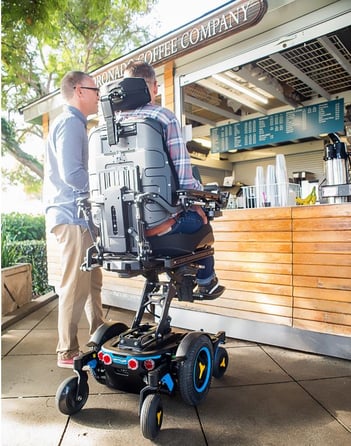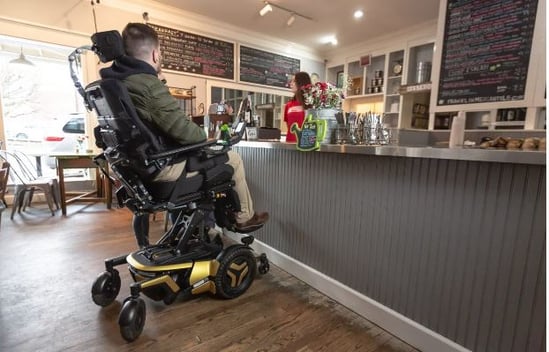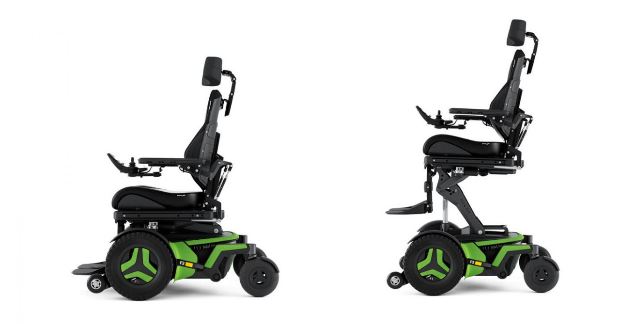This week the spotlight is on power seat elevation, also known as power elevating seat or hi-low. Power seat elevation is a powered seat function that raises and lowers the seat, to provide a varying amount of vertical seat to floor height. It does not change the seated angles of the seat relative to the ground.

Power seat elevate is a power wheelchair seat function that can increase the quality of life for an end user, however it is often a seating function that funders consider ‘desirable’ as opposed to ‘essential’.
For many of our users, we can justify to the funder how power seat elevation is essential to maximise an end user’s independence, often to facilitate independent transfers or increase a person’s vertical reach. Power seat elevation allows the user to adjust the height of their seat to optimise transfers, either by raising the seat to floor height to allow for ease of standing transfer, or to allow the seat to floor height of the power wheelchair to be set just higher than the surface they are transferring to, for ease of use of a transfer board.
Power seat elevation also allows a person to increase their seat to floor height to increase their vertical reach, allowing them to reach items such as a light switch or items in a cupboard that may otherwise be beyond their reach.
RESNA (Rehabilitation Engineering and Assistive Technology Society of North America) have recently updated their Position Paper on the Application of Seat Elevation Devices for Wheelchair Users. For those new to the RESNA Position Papers, these papers summarise current research and best practice trends for a variety of topics. The 2019 update on the use of power seat elevate provides additional insight on where power seat elevate may be beneficial, or perhaps even essential, for end users.

A person is typically prescribed a power wheelchair as they do not have sufficient upper limb function or endurance to achieve all day independent mobility in a manual wheelchair, hence are more likely to have issues with upper limb function and/or fatigue.
A person seated in a power wheelchair is typically positioned at a lower level than their standing peers, which forces a wheelchair user to maintain an upward gaze to achieve eye contact. This can result in a person sitting in increased cervical extension for prolonged periods of time, this posture can be uncomfortable for any person, and can ultimately lead to pain. For those who have an increased thoracic kyphosis, their posture may result in them sitting in a degree of cervical extensional already, hence they may not have sufficient range of movement to allow them to make eye contact with a person in standing.
Use of power tilt can assist with improving eye contact for some users, however this may not be ideal for others who have good upper limb function and need to be positioned upright to maximise their independence.
Many wheelchair users are also living and working in environments that are designed for a person who is standing and walking, for example kitchen bench and cupboard heights are typically set for a person in standing, as are light switches and elevator buttons.
A wheelchair user may have sufficient range of movement to access these environments, however this often results in them reaching above their head, hence using their shoulders towards their end range of movement frequently throughout a day, which can also result in pain and fatigue.

When considering whether to request power seat elevation on a chair, we perhaps need to consider the frequency and duration that a person needs to undertake overhead activities and the potential impact of this over a length of time. It may be that transitioning a person to power mobility may resolve any shoulder pain that was caused by self-propelling, however a person may still experience pain if they are needing to reach overhead a number of times each day as part of maintaining their independence at home or work.
So how much seat elevation can we get on a chair? The amount of seat elevation available varies between 8 and 14 inches, and how this is achieved varies from chair to chair. Power seat elevation on the Permobil chairs is referred to as ActiveHeight, this allows 12” of seat elevate on the Permobil F3 and M3 and 14” on the F5 and M5.
In addition to elevate, the seat also moves back over the base by 3.5” to allow maximum stability while driving the chair in an elevated position. This stability is important for users who may be using ActiveHeight outdoors or for extended periods during the day.
For more information on ActiveHeight on our Permobil chairs, please contact us at sales.nz@permobil.com or call 0800 115 222.
For further information on the RESNA position papers, follow the link here
Rachel Maher
Clinical Education Specialist
Rachel Maher graduated from the University of Otago in 2003 with a Bachelor of Physiotherapy, and later gained her Post Graduate Diploma in Physiotherapy (Neurorehabilitation) in 2010.
Rachel gained experience in inpatient rehabilitation and community Physiotherapy, before moving into a Child Development Service, working with children aged 0 to 16 years.
Rachel later moved into a Wheelchair and Seating Outreach Advisor role at Enable New Zealand in 2014, complementing her clinical knowledge with experience in NZ Ministry of Health funding processes.
